Planning a Pen and Ink Drawing
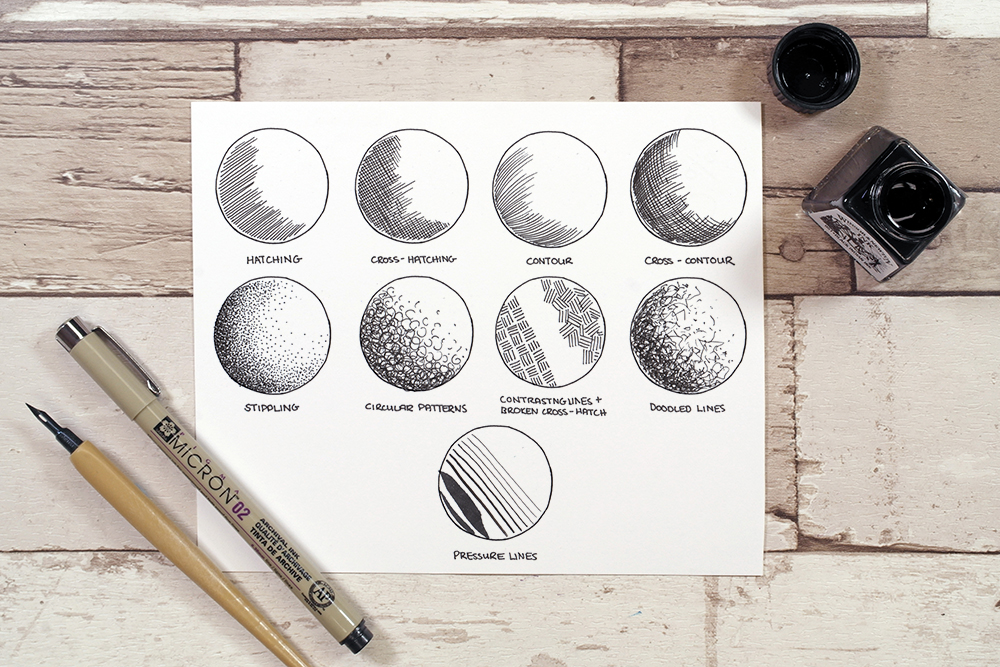
Pen and Ink are the perfect partners for quick and easy mark making – particularly every bit they are affordable and piece of cake to transport. But working in a permanent medium can exist daunting for beginners. Discover our height 9 easy pen and ink cartoon techniques to get you started!
Pen and ink is an ancient drawing medium that has been popular with artists for centuries. Nowadays, we have access to all kinds of wonderful pens that artists of days gone by could but dream of! From fineliners and dip pens, to markers and brush pens – at that place are so many of these drawing tools to choose from. Each offer their own unique properties for pen and ink cartoon.
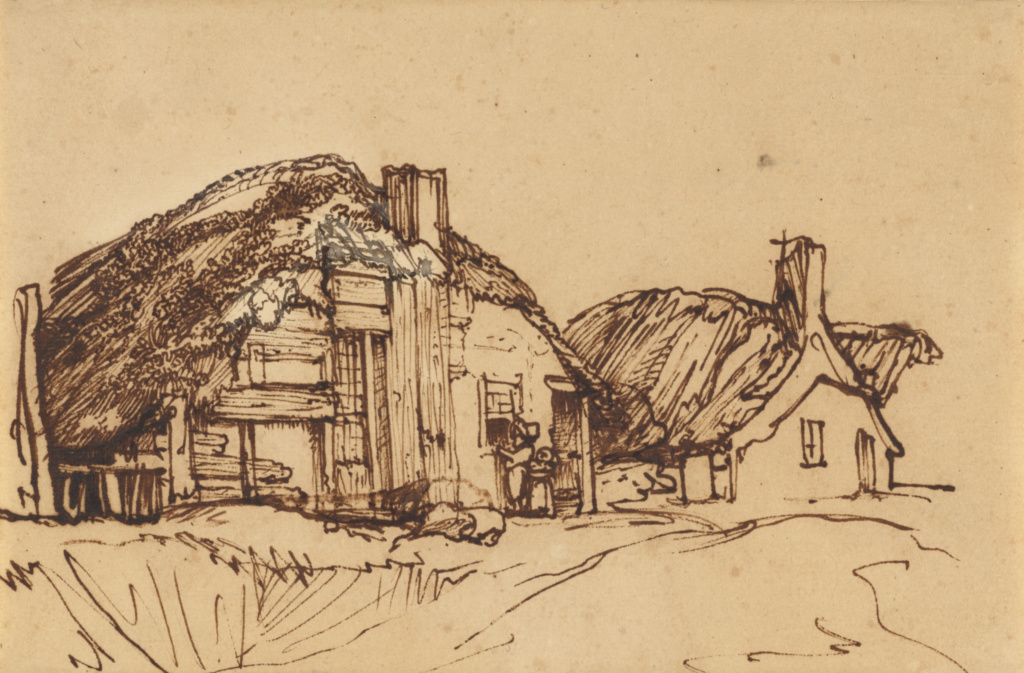
Pen and ink can seem like a big step from pencil drawing – especially for beginners! You can't erase pen, unlike pencil, so your mark making must exist carefully calculated. There's nothing worse than creating the perfect drawing but for it to be ruined by one misplaced line! With pencil you are able to adjust your shading past varying the amount of pressure while drawing. This isn't the case with pens! Yous'll need to rely on carefully placed lines and marks to give the impression of shading. Tightly compacted linework will give the impression of deep shadows, while spaced out linework will create an area filled with low-cal. Juxtaposing both these tight and loose marks volition create a drawing with great contrast and texture.
The 9 easy pen and ink techniques for beginners below offer a nifty starting point, if you are looking to grow in confidence with your pen and ink technique.
What You'll Need to Go Started
If you're merely starting out with ink drawing there are simply a few bits of equipment you will need. Compared to painting, this discipline has a fairly depression cost entry level, so is great for artists who are just beginning their creative journeying or who are looking to level upward their drawing skills. To begin you volition need the following:
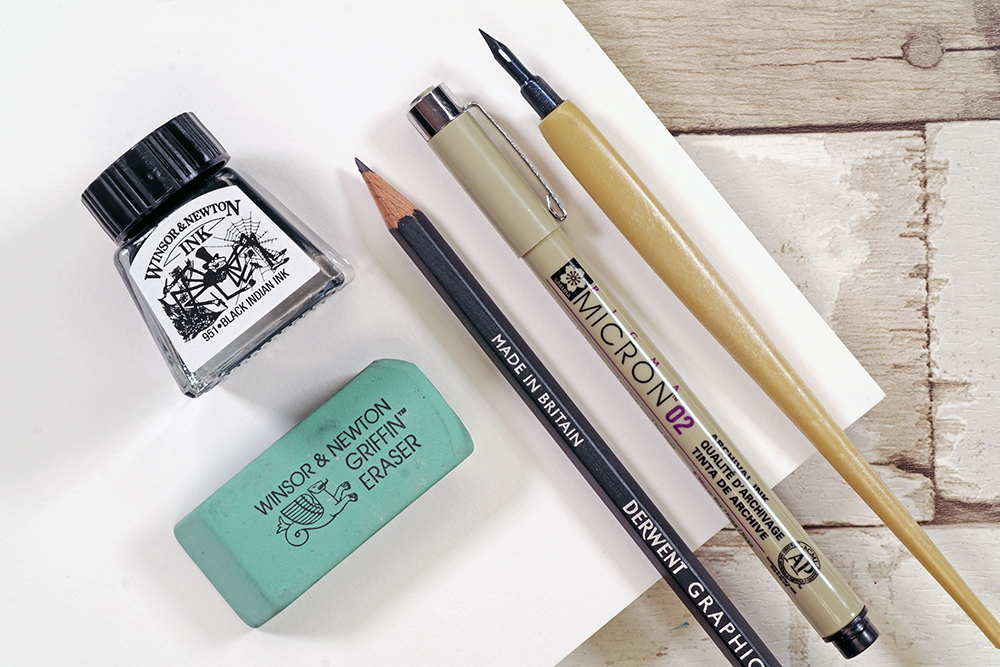
- A pick of drawing pens.
- A dip pen, nibs and appropriate ink if you prefer working with a dip pen.
- Some Cartridge paper.
- Graphite Pencil & eraser if you would prefer to sketch before you ink.
Once you lot take these materials you will be ready to go! Typically the materials you will need for pen and ink are easily transportable, and then if you're taking classes or working on the get creating fine art couldn't be easier!
What are the Differences Between the Types of Pen Available?
There are and then many different types of artists' pens bachelor, information technology tin can be difficult to settle on the right one for you. Especially if yous're a beginner! We'll take a look at a few of the variations of pens we stock and explain the varying qualities they bring to pen and ink drawing.
Fineliners & Technical Pens
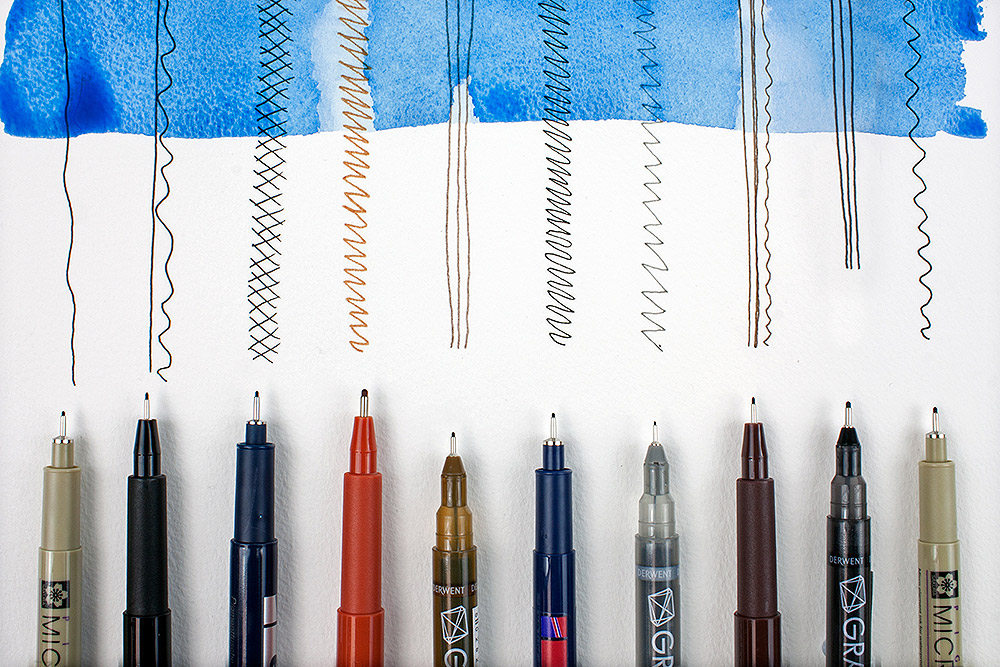
Fineliner pens have a plastic or fibre based nib held in a metallic casing. They have very fine nibs, typically ranging from the smallest 0.03mm size up to 0.8mm, depending on the brand. The nibs all take a fixed width, so the line you get volition be very uniform, consistent and skip-costless. Most of our pens are paint based and waterproof – and then your drawings will be lightfast and tin exist worked over with watercolour or ink later. All of our fineliners are available in black, with select ranges available in other colours. Fineliners are the easiest pens to draw with if y'all're a beginner.
Notice more about our range of fineliners and technical pens in our web log post Go to know Artists Pens – Fineliners & Technical Pens.
Castor Pens
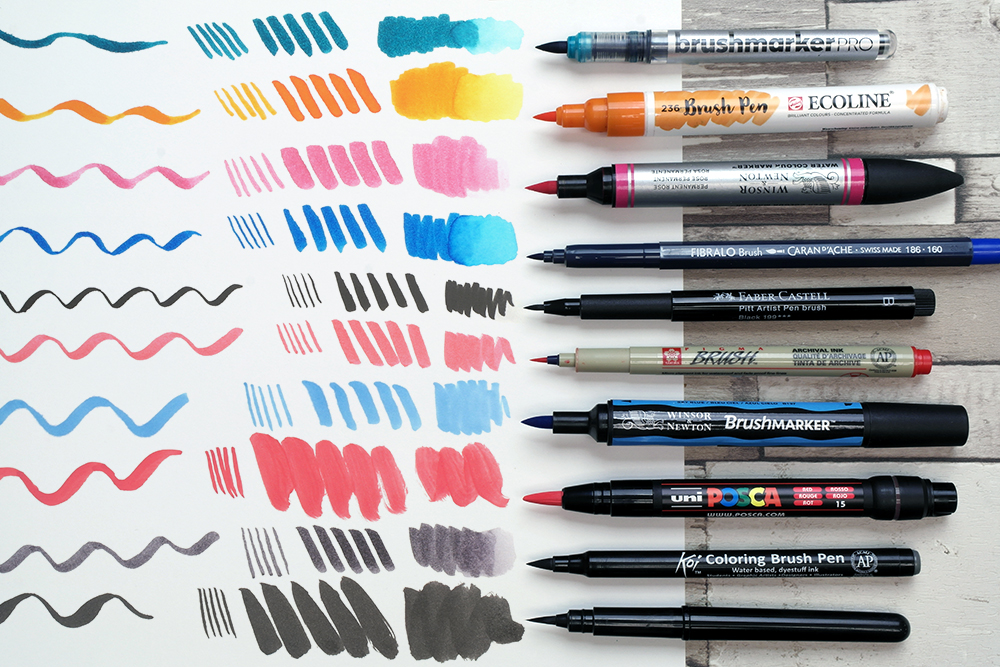
Brush pens offer more than variation in line width than a fineliner pen. Their nibs take a wide base that then tapers to a fine point. Typically the neb is fabricated of a conical piece of felt, just there are pens that have a true brush tip made of individual fibres similar a paint brush. You can vary the weight of your line by adjusting the amount of force per unit area you draw with. Calorie-free pressure will upshot in a fine line, whilst pressing down harder will create a thicker line. They are fantastic if you want more diverseness in line weight and manner in your drawing. Or are looking for a more versatile pen to experiment with. Some brush pens are water-soluble, so you'll need to double check this if you want ink that is permanent.
Discover more near our range of brush pens in our blog postal service Become to know Artists Pens – Brush Pens.
Dip Pens
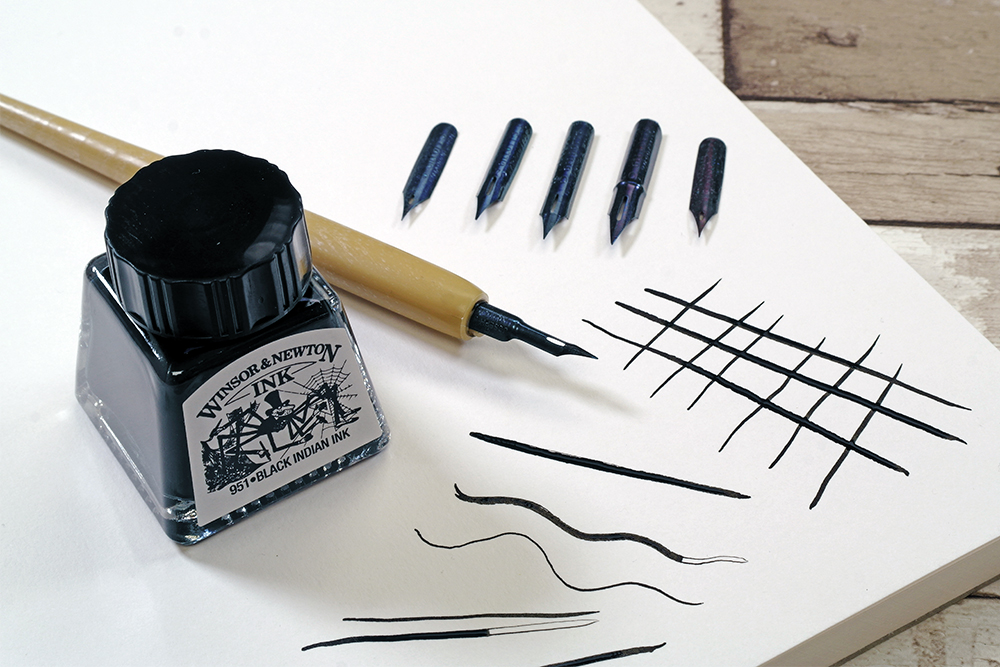
Dip Pens are not cartridge fed like fineliners and brush pens. Instead, you lot dip them into a canteen of ink and re-dip once the ink runs out. This technique is more akin to the types of pen and ink drawing done by artists of the past. 1 benefit of dip pen drawing is that the colours available are virtually unlimited. Most bottled inks are suitable for use with a dip pen, and then in that location will exist plenty of colours to cull from! You too have the choice of working with either water-soluble or waterproof inks, depending on your preference.
Dip Pens don't requite a compatible line. As you apply pressure the flexible tip of the neb will move, allowing more ink to flow from the tip. They also have a tendency to splatter ink if the nib catches on your paper. For some people this splattering can be an annoyance, only for many information technology is role of the charm of drawing with a dip pen. Nibs for dip pens are likewise interchangeable, and then y'all'll be able to swap them out if you fancy a change.
Yous can use other speciality pens, like calligraphy pens, for line drawing. These types of pens have peculiarly designed nibs ordinarily used for hand lettering techniques. You tin utilize them to achieve precise marks and textures for cartoon. They do require a bit of experimentation before you get the hang of using them.
Get started with the 9 inking techniques beneath and you should slowly and surely exist able to build upwardly your ink drawing skills!
Technique 1: Hatching
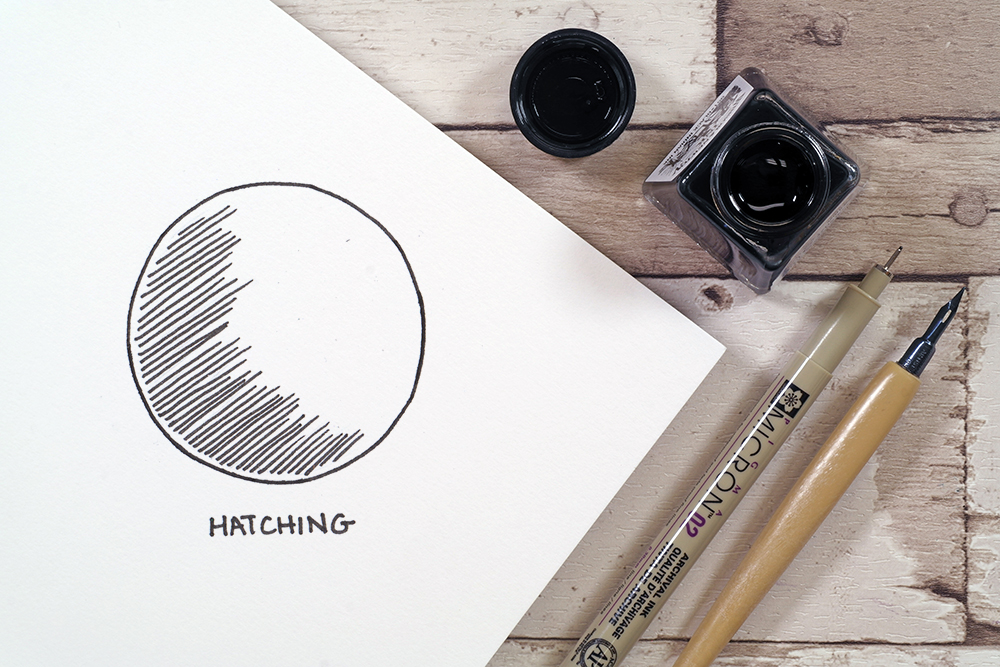
Hatching is the easiest and one of the most bones ink drawing techniques. To hatch you essentially create a serial of horizontal parallel lines. You can use a ruler to get sharp directly lines for an architectural look but freehand lines will give your drawings more graphic symbol. The closer together you lot draw your lines, the more than dense the shading effect they will create. The further autonomously they are the lighter the shading will appear. This technique is all-time for shading areas with medium shadow.
Technique 2: Cross-Hatching
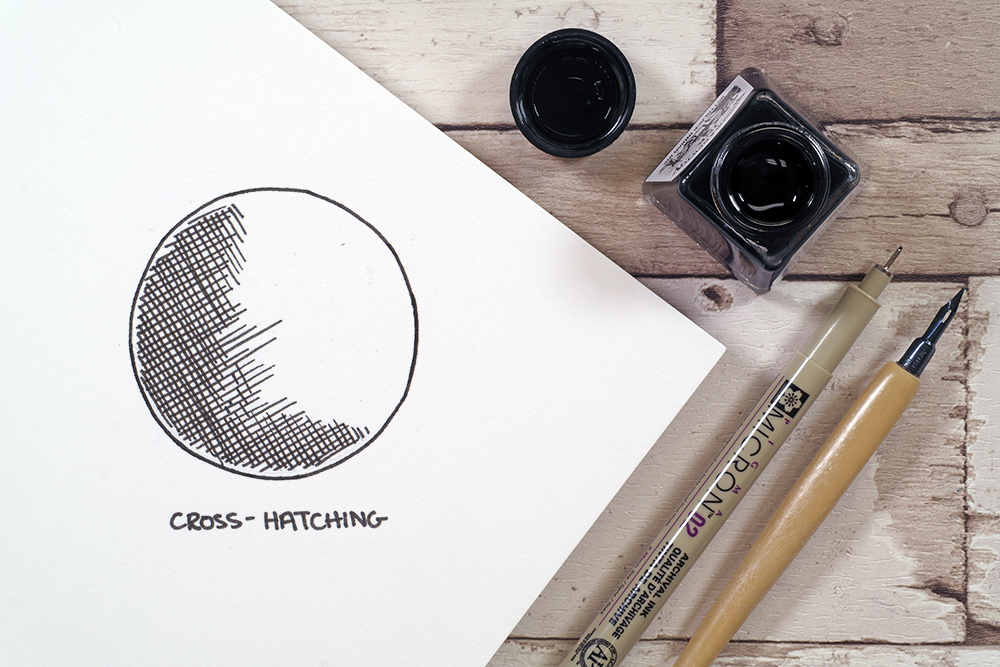
Cross-Hatching builds on the Hatching technique. Essentially you'll need to start by creating the same hatched lines as before. Once you're done you lot'll create another layer of hatched lines that overlap your existing linework. This second layer is commonly washed at a 90 degree angle, but you can add them in as many layers and angles every bit you choose. The more layers y'all add at different angles the more than dense your shading will become. Use Cross-Hatching for creating areas of deep shadows while creating texture.
Technique 3: Contour
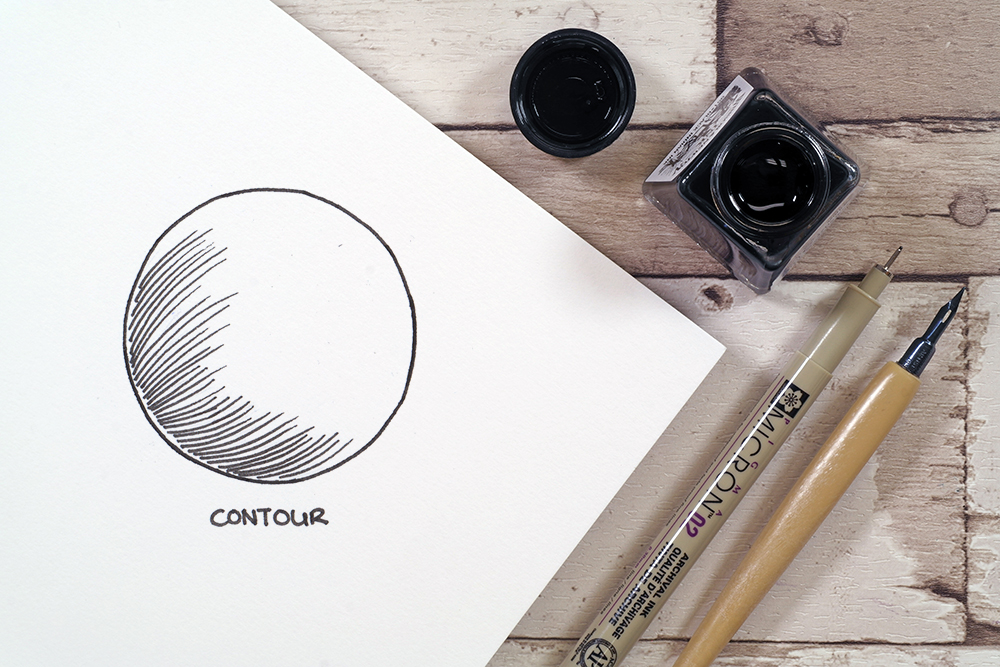
Contour shading works similarly to Hatching, but your lines will follow the curves of the object you are drawing. If you lot are drawing a curved object then using contoured lines over uncomplicated hatching will give more than illusion of shape. Hatching tin can leave your drawings looking a footling flat. Every bit with hatching, the closer together the lines, the deeper the shadow issue. Don't worry about your lines being perfect – little imperfections volition give your cartoon character.
Technique 4: Cantankerous-Contour
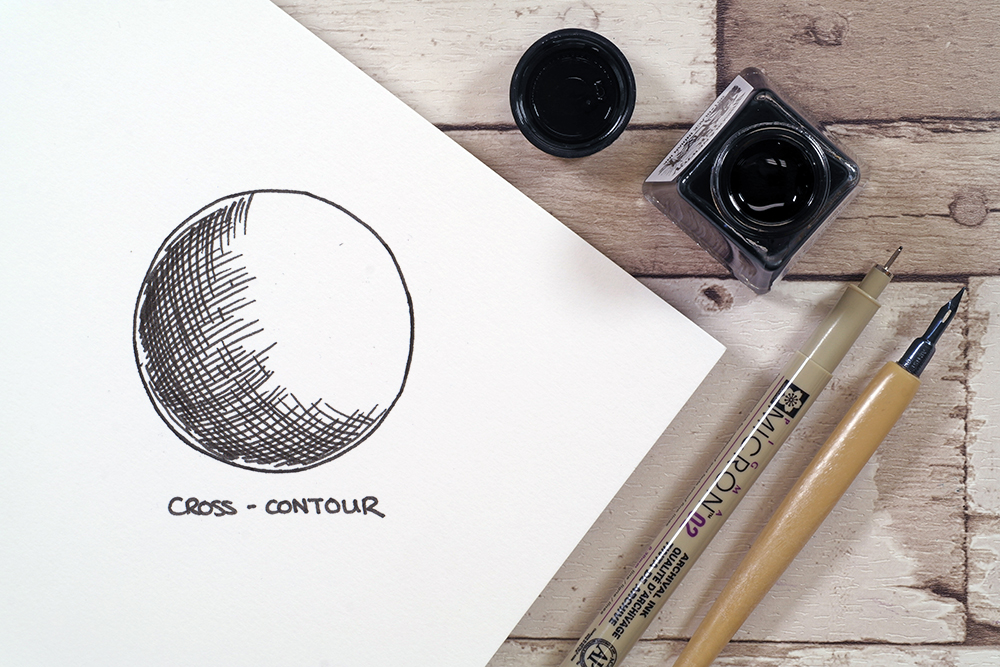
Cross-Contour works along the same principle as Cantankerous-Hatching, just you volition start with contoured lined rather than hatched lines. Again, yous can add in as many layers and directions as y'all want to build up the shadow density you need.
Technique 5: Stippling
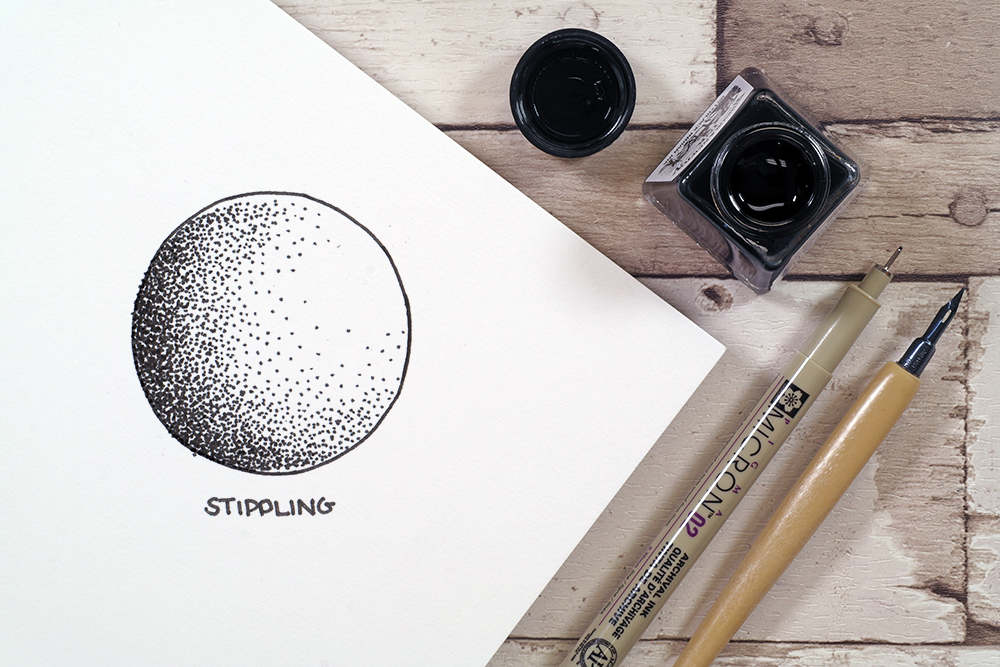
Stippling is one of the more time consuming pen and ink techniques. Information technology relies on carefully placed dots to give the impression of shadow and depth. The more densely concentrated your dots, the deeper the shadow will be. Create each dot past pressing the beak of your pen confronting the paper – you lot aren't really 'drawing' and filling each private circle. The smaller the neb size of your pen, the smaller your stippled dots volition be. In areas that have very little shading y'all will only demand to place a few strategic dots here and at that place. It can accept a long time to build up your shading, especially if yous re working on a large piece. Consider the size of the nib y'all apply and don't lose your cool! This technique gives ultimate command over the contrast between calorie-free and dark in your work.
Technique vi: Circular Patterns
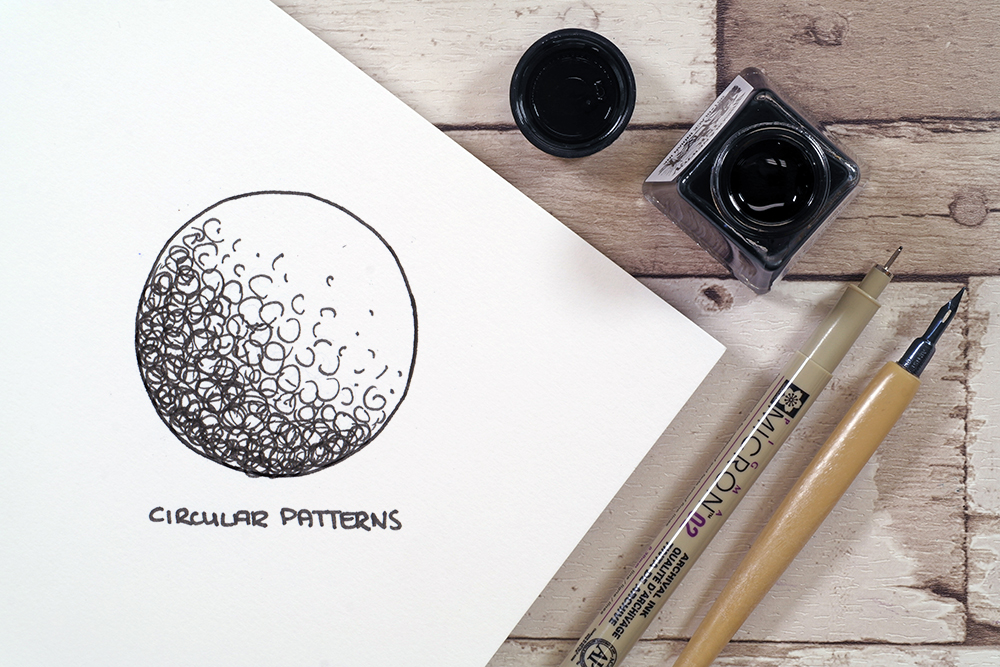
Utilize Circular Patterns to create areas of both lite and dark shadow. The larger, looser and less tightly packed your circles the lighter your shading volition exist. As your circles become smaller and more dense your shading volition announced much darker. This technique is slap-up for quickly capturing natural textures in a uniform fashion – try using information technology to give the impression of foliage or scales.
Technique 7: Contrasting Lines & Cleaved Cross-Hatch
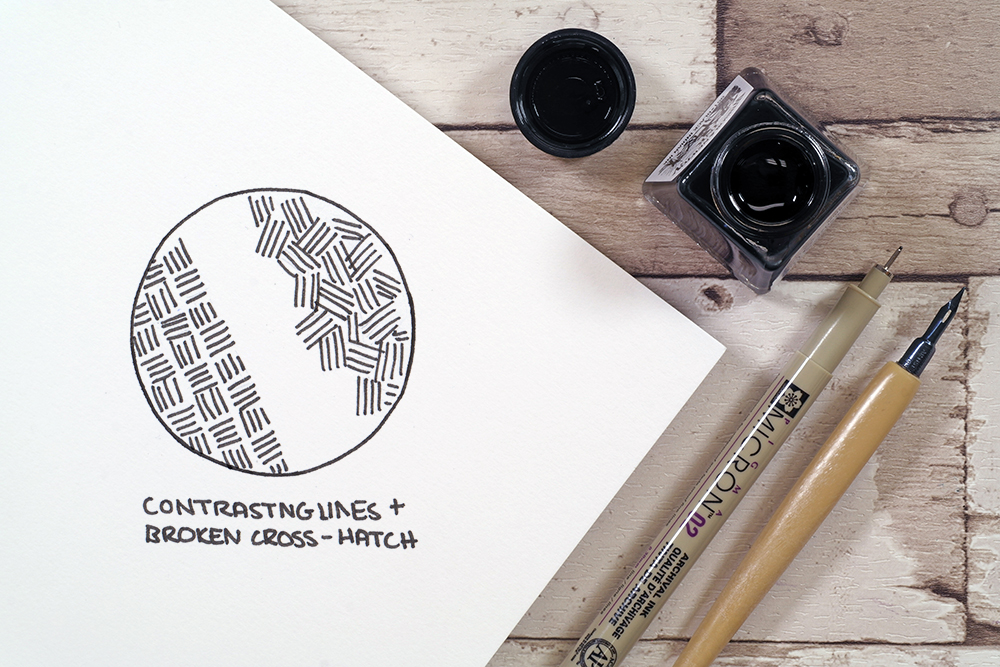
Contrasting lines and Broken Cross Hatch are two similar techniques that work the same way equally a regular cross hatch. Contrasting lines (sometimes chosen 'weaving') is used to create a pattern where pocket-sized groups of hatched lines are drawn at angles to each other. These lines can be fabricated in a compatible arrangement, or placed in a more random manner depending on the texture you desire to create. You can overlap these lines to create an unbroken pattern.
Broken Cross-Hatch is similar simply works with groups of intersecting cross-hatched lines. The more your lines intersect the darker the shading volition exist. Both these techniques generate an aesthetically pleasing texture.
Technique 8: Continuous & Random Doodled Lines
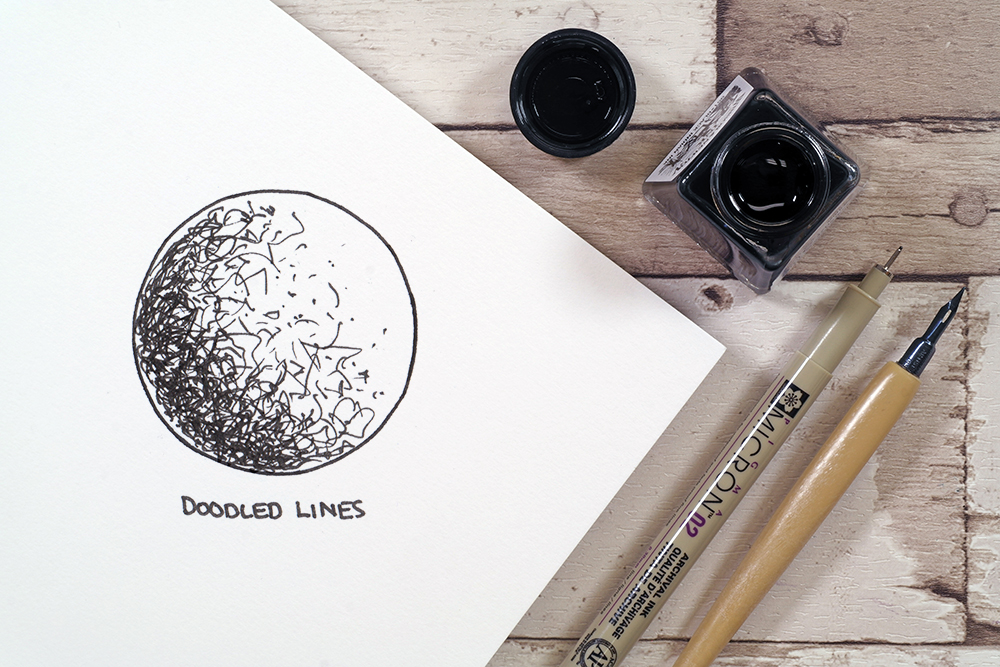
Continuous and doodled lines are usually made up of ane unbroken or a few very long weaving and overlapping lines. These lines shouldn't be fabricated in whatsoever sort of predictable pattern. Rather, you should relax your manus and only brainstorm to create instinctive marks. It tin can take a fiddling bit of practice to let become and relax, while as well bearing in mind not to go overboard. In one case yous've practiced a footling you'll soon be able to create shading that'due south perfect for giving the impression of textures like leaves, bark and more than!
Technique 9: Force per unit area Lines & Thickness
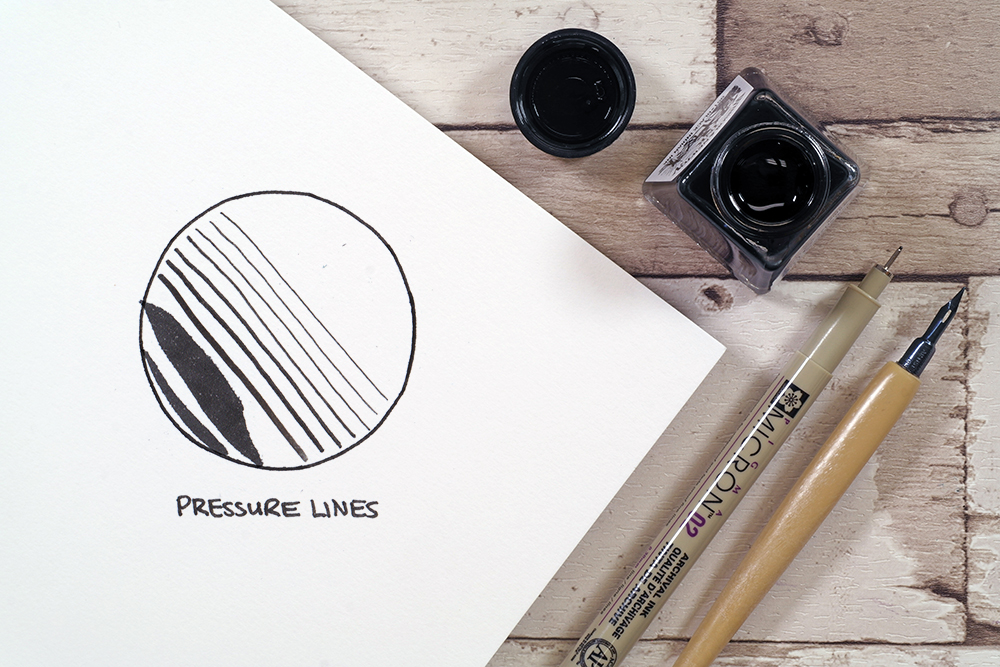
This technique makes utilise of the dissimilar sizes and styles of nibs bachelor. If yous are working with fine liner pens there volition be lots of different nib thicknesses bachelor to you. Using a combination of these thicknesses in your drawings will brand it easier to create varying degrees of shading. Try mixing upwards the sizes of pens you use to see how different sizes affect the types of linework you tin can create.
With Brush pens you'll find that the more than pressure you put on the pen, the thicker your linework volition be. This allows y'all to create a single line with a varying line weight – something that y'all can use to your reward in your drawings. The thickest lines can be used to create dramatic shadows, while the variation in line weight volition give your cartoon more graphic symbol.
Other Hints & Tips
- If you're just starting out brainstorm by practicing these techniques on simple geometric shapes. Start out with a cube and work out how light and shadow volition affect each of its faces. Try and translate this dissimilarity in dark and light into a drawing using the techniques above.
- As you abound in conviction beginning trying to render more circuitous objects. It can be useful to describe these objects from life to see how light and shadow announced in a real life setting. Try capturing mugs, spectacles and other household items.
- If you're nervous nigh putting pen to paper endeavor planning your drawing with pencil first. This planning will help you work out where your lines need to be placed, without worrying besides much nigh making mistakes.
- Endeavor pens with specialist nibs, like the Pilot Parallel Pen for some interesting marking making techniques.
- Try mixing upward different techniques to help define the form of the object you are sketching. Cross hatching and contour are usually used together.
- Use a mixture of different pens in the same drawing.
- Change the manner you concur your pen. Holding your pen at the bottom volition allow for more than free, expressive lines, whereas holding it close to the pecker will allow you to work in more particular.
- Add together water to water-soluble linework to add together character and interest to your drawing.
- Use dry pens for texture. Using a dry marker, felt tip or brush pen can add together texture to your work every bit they create a cleaved stroke of ink.
- Use coloured pens to add a bit of vibrance to your drawings.
Source: https://www.artsupplies.co.uk/blog/9-easy-pen-and-ink-techniques-for-beginners/
0 Response to "Planning a Pen and Ink Drawing"
Post a Comment